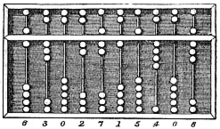Computing hardware
evolved from machines that needed separate manual action to perform
each arithmetic operation, to punched card machines, and then to
stored-program computers.
The history of stored-program computers relates first to computer
architecture, that is, the organization of the units to perform input
and output, to store data and to operate as an integrated mechanism.
Before the development of the general-purpose computer, most
calculations were done by humans. Mechanical tools to help humans with
digital calculations were then called "calculating machines", by
proprietary names, or even as they are now,
calculators.
It was those humans who used the machines who were then called
computers. Aside from written numerals, the first aids to computation
were purely mechanical devices which required the operator to set up the
initial values of an elementary arithmetic operation, then manipulate
the device to obtain the result. A sophisticated (and comparatively
recent) example is the
slide rule
in which numbers are represented as lengths on a logarithmic scale and
computation is performed by setting a cursor and aligning sliding
scales, thus adding those lengths. Numbers could be represented in a
continuous "analog" form, for instance a voltage or some other physical
property was set to be proportional to the number. Analog computers,
like those designed and built by
Vannevar Bush
before World War II were of this type. Numbers could be represented in
the form of digits, automatically manipulated by a mechanical mechanism.
Although this last approach required more complex mechanisms in many
cases, it made for greater precision of results.
The invention of electronic amplifiers made calculating machines much
faster than their mechanical or electromechanical predecessors.
Vacuum tube (thermionic valve) amplifiers gave way to solid state
transistors, and then rapidly to
integrated circuits
which continue to improve, placing millions of electrical switches
(typically transistors) on a single elaborately manufactured piece of
semi-conductor the size of a fingernail. By defeating the
tyranny of numbers,
integrated circuits made high-speed and low-cost digital computers a
widespread commodity. There is an ongoing effort to make computer
hardware faster, cheaper, and capable of storing more data.
Computing hardware has become a platform for uses other than mere
computation, such as process automation, electronic communications,
equipment control, entertainment, education, etc. Each field in turn has
imposed its own requirements on the hardware, which has evolved in
response to those requirements, such as the role of the
touch screen to create a more intuitive and
natural user interface.
As all computers rely on digital storage, and tend to be limited by the size and speed of memory, the history of
computer data storage is tied to the development of computers.
Earliest true hardware
Devices have been used to aid computation for thousands of years, mostly using
one-to-one correspondence with our
fingers. The earliest counting device was probably a form of
tally stick. Later record keeping aids throughout the
Fertile Crescent
included calculi (clay spheres, cones, etc.) which represented counts
of items, probably livestock or grains, sealed in containers.
[1][2] The use of
counting rods is one example.
The
abacus was early used for arithmetic tasks. What we now call the
Roman abacus was used in
Babylonia as early as 2400 BC. Since then, many other forms of reckoning boards or tables have been invented. In a medieval European
counting house,
a checkered cloth would be placed on a table, and markers moved around
on it according to certain rules, as an aid to calculating sums of
money.
Several
analog computers were constructed in ancient and medieval times to perform astronomical calculations. These include the
Antikythera mechanism and the
astrolabe from
ancient Greece (c. 150–100 BC), which are generally regarded as the earliest known mechanical analog computers.
[3] Hero of Alexandria (c. 10–70 AD) made many complex mechanical devices including automata and a programmable cart.
[4] Other early versions of mechanical devices used to perform one or another type of calculations include the
planisphere and other mechanical computing devices invented by
Abū Rayhān al-Bīrūnī (c. AD 1000); the
equatorium and universal latitude-independent astrolabe by
Abū Ishāq Ibrāhīm al-Zarqālī (c. AD 1015); the astronomical analog computers of other medieval
Muslim astronomers and engineers; and the
astronomical clock tower of
Su Song (c. AD 1090) during the
Song Dynasty.

Suanpan (the number represented on this abacus is 6,302,715,408)
Scottish mathematician and physicist
John Napier
noted multiplication and division of numbers could be performed by
addition and subtraction, respectively, of logarithms of those numbers.
While producing the first logarithmic tables Napier needed to perform
many multiplications, and it was at this point that he designed
Napier's bones, an abacus-like device used for multiplication and division.
[5] Since
real numbers can be represented as distances or intervals on a line, the
slide rule
was invented in the 1620s to allow multiplication and division
operations to be carried out significantly faster than was previously
possible.
[6]
Slide rules were used by generations of engineers and other
mathematically involved professional workers, until the invention of the
pocket calculator.
[7]

Yazu Arithmometer. Patented in Japan in 1903. Note the lever for turning the gears of the calculator.
Wilhelm Schickard, a German
polymath,
designed a calculating clock in 1623. It made use of a single-tooth
gear that was not an adequate solution for a general carry mechanism.
[8]
A fire destroyed the machine during its construction in 1624 and
Schickard abandoned the project. Two sketches of it were discovered in
1957, too late to have any impact on the development of mechanical
calculators.
[9]
In 1642, while still a teenager,
Blaise Pascal started some pioneering work on calculating machines and after three years of effort and 50 prototypes
[10] he invented the
mechanical calculator.
[11][12] He built twenty of these machines (called
Pascal's Calculator or Pascaline) in the following ten years.
[13] Nine Pascalines have survived, most of which are on display in European museums.
[14]
Gottfried Wilhelm von Leibniz invented the
Stepped Reckoner and his
famous cylinders
around 1672 while adding direct multiplication and division to the
Pascaline. Leibniz once said "It is unworthy of excellent men to lose
hours like slaves in the labour of calculation which could safely be
relegated to anyone else if machines were used."
[15]
Around 1820,
Charles Xavier Thomas created the first successful, mass-produced mechanical calculator, the Thomas
Arithmometer, that could add, subtract, multiply, and divide.
[16] It was mainly based on Leibniz' work. Mechanical calculators, like the base-ten
addiator, the
comptometer, the
Monroe, the
Curta and the
Addo-X remained in use until the 1970s. Leibniz also described the
binary numeral system,
[17] a central ingredient of all modern computers. However, up to the 1940s, many subsequent designs (including
Charles Babbage's machines of the 1822 and even
ENIAC of 1945) were based on the decimal system;
[18] ENIAC's ring counters emulated the operation of the digit wheels of a mechanical adding machine.
In Japan,
Ryōichi Yazu
patented a mechanical calculator called the Yazu Arithmometer in 1903.
It consisted of a single cylinder and 22 gears, and employed the mixed
base-2 and base-5 number system familiar to users to the
soroban (Japanese abacus). Carry and end of calculation were determined automatically.
[19] More than 200 units were sold, mainly to government agencies such as the Ministry of War and agricultural experiment stations.
source





























